Product attributes are crucial in distinguishing your brand in the crowded ecommerce world, providing the means to meet specific customer needs and enhancing search engine visibility.
Strategic use of product attributes can improve your visibility in search engines, helping match your offerings with shoppers' specific needs and enhancing the likelihood of being found.
Features are factual product details, while benefits explain their value to customers. Pairing them helps convey emotional or practical value, enriching the customer experience.
Whether tangible or intangible, product attributes like quality and price influence buying decisions, helping customers find products aligning with their needs and desires.
Attributes need to be accurate, fresh, and verified for quality and safety. This reassures customers, reduces returns, and maintains trust in your brand.
Product attributes are key to getting your brand noticed in the increasingly crowded ecommerce marketplace.
Brands need to offer potential customers what they want in a format that makes it easy for the average joe or jane to find.
With the flexibility offered by modern ecommerce platforms, it’s important to understand and take advantage of the opportunities within strategic product attribution.
Use product attributes to show up in search engines and speak to shoppers’ extremely specific needs and wants. When we match our classification of products on the product details page according to consumer behavior and habits, we’re in business.
Shoppers look for and buy goods and services with specific product attributes.
Ecommerce marketers must hone their target audience and build product descriptions that capture customers' desires. Using product attributes in your marketing strategy is critical in attaining brand success.
Each specific attribute must be a positive selling point to create a lasting impression. Let's start by defining the concept and narrow in on the specifics as we go.
What are Product Attributes?
Product attributes refer to the characteristics of a product that define how customers research and buy.
Your brand internally identifies products using a unique code or SKU (stock-keeping unit) to help differentiate between products in its inventory management system. But, your customers see and search for products in very different ways.
Customers use natural language and descriptive words in their search queries, such as “large family tent” or “affordable waterproof jacket.”
Like you, they are humans. Always remember, you are talking to humans.
Why Are Product Attributes Important?
Product attributes do more than fill out a product sheet—they shape every step of the shopping experience and hit your bottom line.
- Slash preventable returns. 54% of customers say they’ve returned an online purchase because the product information was faulty or misrepresented, and 56% point to misleading or poor product content as the culprit.
- Power search visibility. 66% of consumers use a search engine to research products before they buy, and 71% kick off their shopping journey there.
- Earn trust and loyalty. 83% of shoppers will abandon a site that provides insufficient product information, and 73% think less of a brand when details are incomplete or inaccurate.
- Boost conversions. Accurate, well-written descriptions and specs can lift conversion rates by up to 78%, while unclear or misleading content drives abandoned carts and lost sales.
Accurate, compelling attributes are non-negotiable—get them wrong, and your customers will click away.
Tangible vs intangible product attributes
Attributes are further defined as tangible (physical) or intangible (non-physical).
- Tangibles are characteristics such as size, color, smell, product design, weight, etc.
- Intangible refers to things like price, quality, and aesthetics.
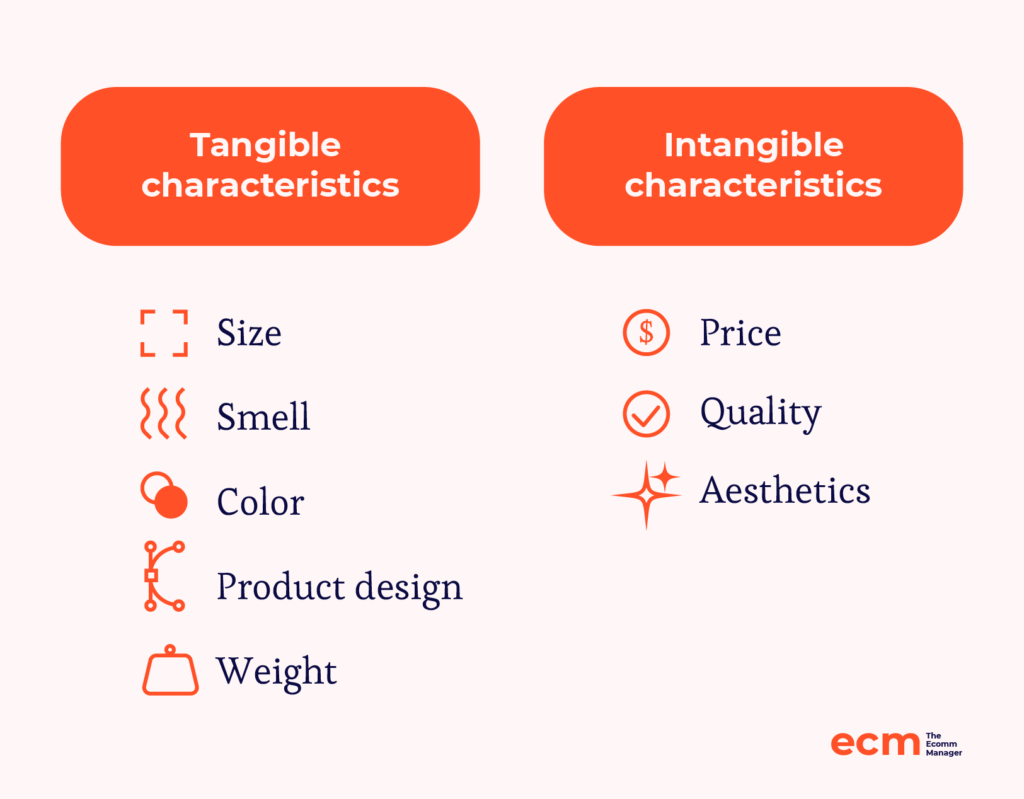
Buyers use a combination of these various product attributes to make a buying decision. They are looking for a product that meets their needs and their wants.
Customer needs are must-haves in a product, and wants are desired but not critical. Buyers select a product that best matches these needs and wants.
Difference between features and benefits
Clearly distinguishing features from benefits helps customers immediately understand why a product matters to them. It also transforms your product descriptions from basic fact lists into persuasive selling tools.
- Features are factual, objective attributes of your product.
- They’re measurable or observable aspects like material, weight, size, or technical specifications.
- For example, a smartphone’s battery capacity (e.g., "4,500 mAh") or fabric composition of a jacket ("100% recycled nylon") are features.
- Benefits explain how those features improve your customer’s life or solve a problem.
- They communicate emotional or practical value, answering the critical customer question: “Why should I care?”
- For example, a phone’s battery feature becomes a benefit when described as “All-day power, so you don’t miss important moments,” and recycled nylon translates into “Comfortably sustainable clothing you can feel good about.”
Pairing product features directly with their benefits creates a compelling story that resonates with shoppers, motivates purchases, and highlights your product’s true value.
Types of Product Attributes
When people search for products, they need to quickly get key details about their options and easily compare them to find the right fit. It's important to list the product attributes that will matter most to your prospective buyer.
Product attributes must be accurate and informative.
Listen to customer feedback, take advantage of reading product reviews (these also help with making product improvements), and understand how your product is meeting, or failing to meet, customer expectations.
Here are the different types of product attributes that can describe your product, plus a few helpful examples of product attributes at work.
Quality
This should be your brand's primary product attribute when pushing for market placement.
People are drawn to products they know and they trust will work. Generating positive reviews and solid manufacturing data are two ways of demonstrating a product’s quality.
This requires work.
Companies that ensure their chain of product development, production, quality assurance, and control, as well as customer service, are all consistent with producing a high-end product will win stellar reviews that validate its quality.
Quality attributes are necessary for the product to get discovered by shoppers and drive sales. Examples of quality-related attributes include:
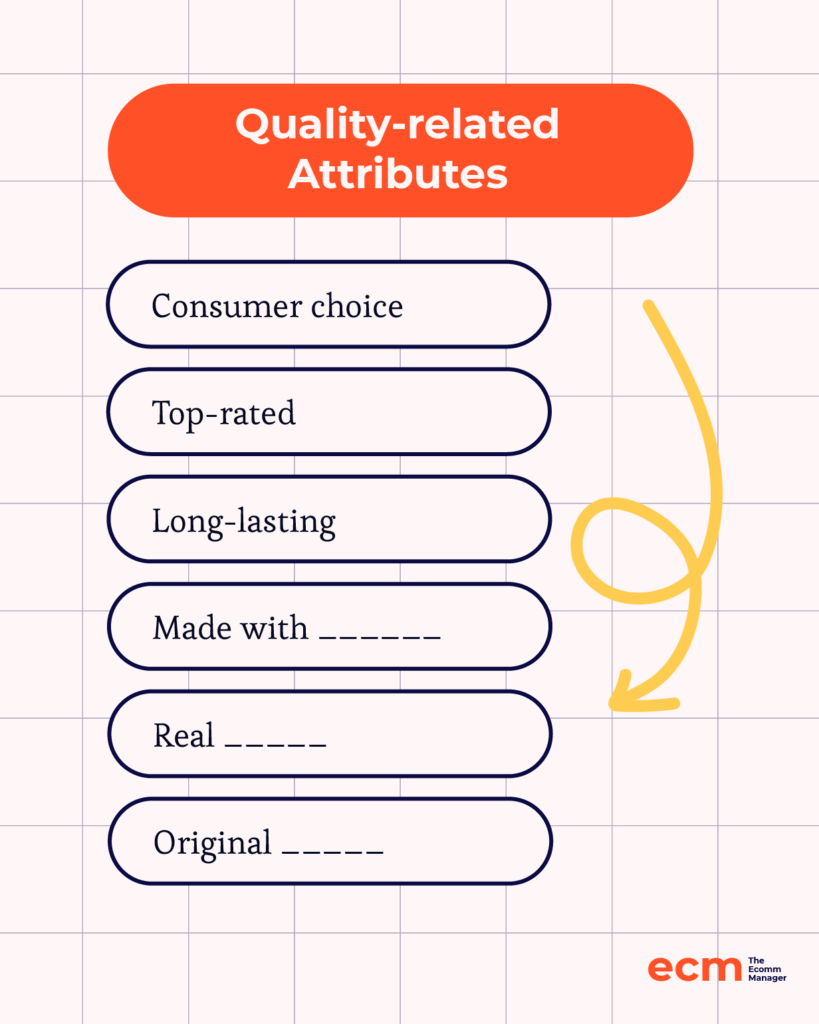
- Consumer choice
- Top-rated
- Long-lasting
- Made with ____
- Real ____
- Original ____
Marketing claims
Marketing claims are those relating to your product's performance.
They can be both objective and subjective. Brands invest time and money into conducting market research via groups and customer surveys to create a persuasive stat to entice customers.
Examples of marketing claim attributes include things like:
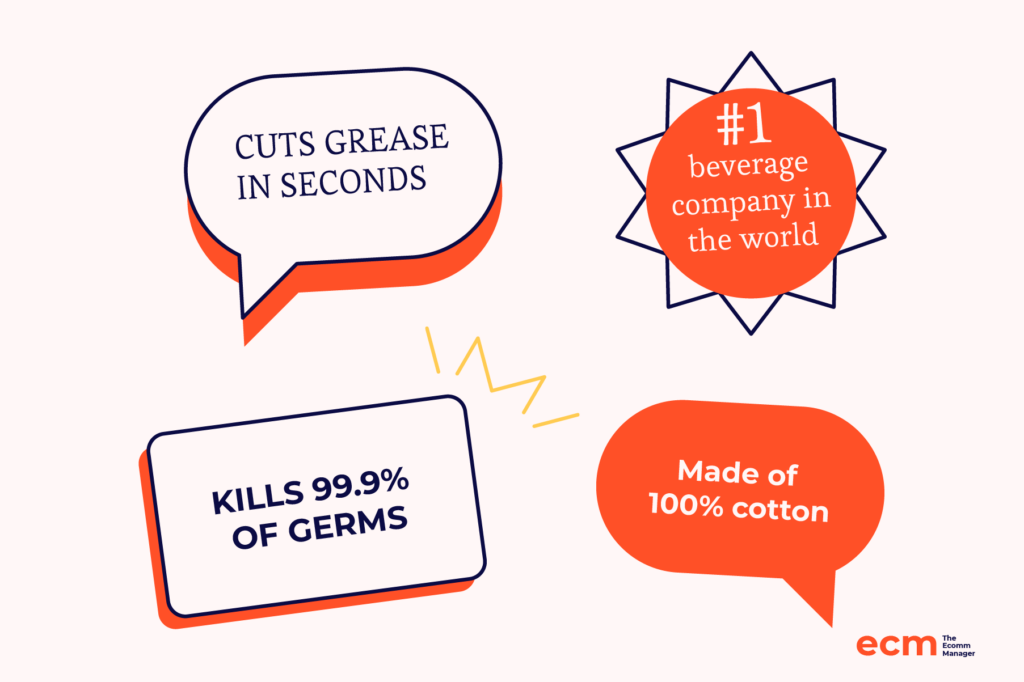
- "Cuts grease in seconds"
- "#1 beverage company in the world"
- "Kills 99.9% of germs"
- "Made of 100% cotton"
However, it's important to be aware that false claims, or statements modified to twist attributes, can cause marketing problems.
A dishonest or weak claim can devalue your product and brand.
While this can fool shoppers into buying once or twice, the product will ultimately fail to live up to the hype you created and customers will shop elsewhere. Even worse, you may have to contend with bad reviews on top of the inevitable churn.
Extensive testing to verify and support marketing claims will help avoid the problem of misidentifying product attributes and strengths.
Consumers will find your products through accurate product marketing claims and become repeat buyers when those claims are verified through a great customer experience.
Innovative attributes
Some products and services in the marketplace have been around for generations.
Items like laundry or cleaning products are perfect examples. However, if your company wants to stay ahead of the regular market brands, innovations can help reinvigorate sales.
Keeping products fresh, whether well-established or new to the market, can be achieved by mining the data of a product category to analyze, assess, and rework products.
This allows you to create next-generation products built on a strong foundation of tried and true products with loyal customers.
Focusing on increased reliability, a new look, extended shelf life, sustainable materials, and other needed improvements can differentiate your product and attract new customers.
Verification and safety
While color or size attributes can influence a customer's purchase, another very important tangible attribute is a product’s proven safety credentials. You can't ignore this variant, as shoppers deeply value trustworthy and safe products.
Examples of verification-related attributes are:
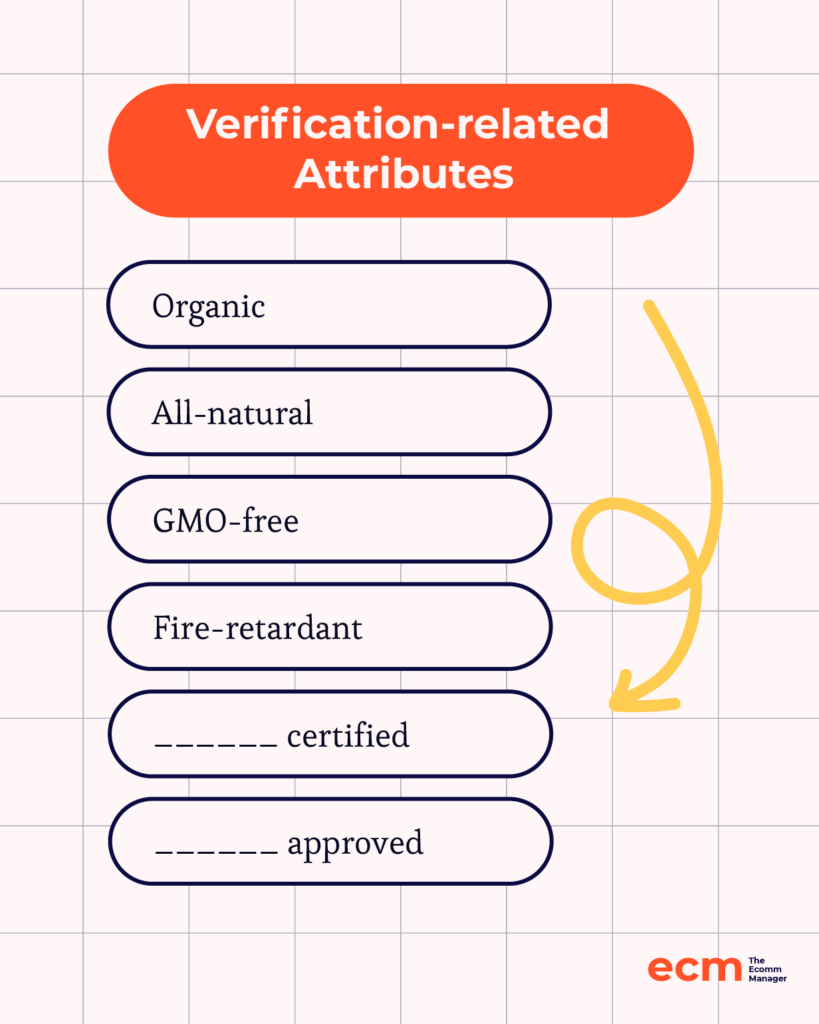
- Organic
- All-natural
- GMO-free
- Fire-retardant
- _____ certified
- _____ approved
All these attributes are critical to making the consumer feel safe that the product can be trusted.
Verification studies can be conducted at specialized labs to meet all safety needs. This works in any area of product and service support.
Catching product and service issues before a product hits the market also means fewer negative reviews and reduces the chance of product recalls and returns. Verified safety attributes will help consumers find your products and feel good about buying them.
17 Product Attributes That Motivate Purchases
The list of tangible and intangible product attributes is nearly endless. Here's a comprehensive (but by no means exhaustive) list of product attributes:
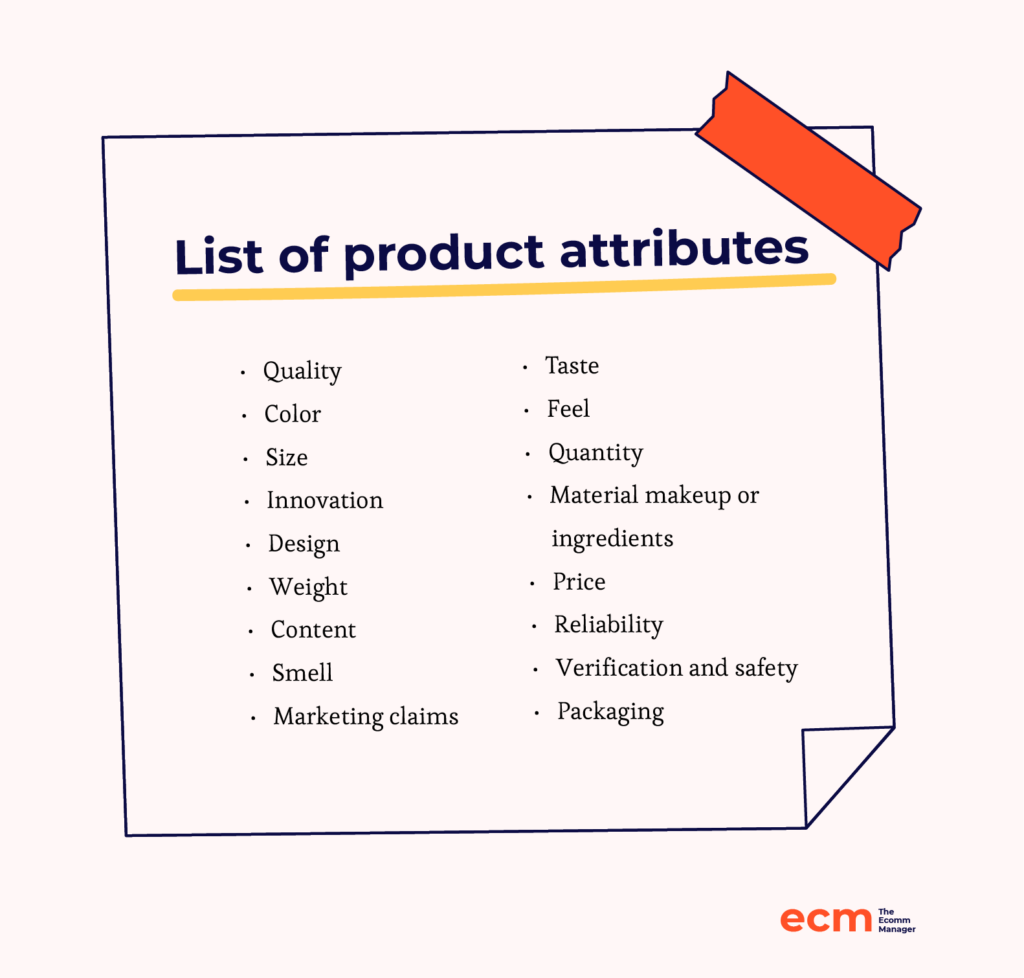
- Quality: This refers to how well the product performs in relation to its intended purpose and its durability over time. High-quality products are usually made from superior materials, manufactured with precision, and have less likelihood of defects.
- Color: This relates to the product's hue, saturation, and brightness. Color also influences customer purchasing decisions, as it often conveys certain emotions or meanings.
- Size: Size pertains to the physical attributes of the product, like length, width, and height. It also could include volume or capacity, depending on the product type.
- Innovation: This refers to how novel or advanced the product is regarding technology or ideas. An innovative product often has unique features or functionalities that set it apart from its competitors.
- Design: Design encompasses both the aesthetic appearance and the product's functionality. It involves the shape, color, texture, and ergonomic features of a product that make it comfortable and easy to use.
- Weight: This is the measure of how heavy the product is. Weight can impact shipping costs, ease of use, and even the perceived quality of the product.
- Content: This could refer to what's included in the product package or the actual information or features contained in a product, especially for digital or media products.
- Smell: For certain products like food, beverages, perfumes, and cleaning products, the scent or odor can greatly influence customer satisfaction.
- Taste: This attribute is crucial for food and beverage products. It refers to the flavor profile, which could be sweet, sour, salty, bitter, umami, or a combination thereof.
- Feel: The tactile sensation when a customer interacts with the product. It could refer to the texture, hardness, temperature, or weight of the product.
- Quantity: Quantity pertains to how much of the product is sold in a single unit or package. This could refer to the number of items, the volume, or the weight.
- Material composition or ingredients: Literally, it's what is in the product. For food items, this would be the ingredients list. For non-food items, it could be the type of fabric, metal, or plastic used.
- Price: This is the cost to the customer to purchase the product. Price is often a key deciding factor for consumers and can reflect the product's perceived value.
- Reliability: Reliability pertains to how consistently the product performs its intended function without failures over a certain period.
- Verification and safety: Verification refers to the processes in place to ensure the product meets specific standards or claims. Safety relates to the product's potential risks or hazards to the user.
- Packaging: This involves how the product is presented and protected. Good packaging can enhance the product's appeal, provide important information, and ensure the product reaches the customer undamaged.
- Marketing claims: These are statements made by the brand about the product's features, benefits, or performance, used to persuade customers to buy. They should be truthful and verifiable (for example, through case studies or consumer research).
Use this list to highlight the right attributes and ensure they help consumers find the product and trigger them to buy.
This list can help marketers highlight a custom product’s attribute selection and ensure customers see these positives in their online product searches. Product attributes should be easy to find in product descriptions, under an attributes tab or menu, or on the main page.
5 Best Practices for Managing Product Attributes
Poorly managed product attributes lead to costly returns, lost sales, frustrated shoppers, and internal chaos. Getting a clear system in place for managing these attributes is essential to maintain accuracy, consistency, and profitability.
Here’s how to tighten your approach and ensure your product attributes actively drive growth.
1. Establish cross-functional collaboration
Managing product attributes takes place across multiple teams.
Merchandising, marketing, IT, fulfillment, and customer service teams all depend on accurate product information to perform their roles effectively.
Without strong collaboration, teams operate in silos—leading to miscommunications, inconsistencies, and avoidable mistakes that hurt both customers and your bottom line.
Here’s how to break the silos down:
- Create a dedicated “Attribute Council”. Form a small, cross-team working group to meet monthly or quarterly. This council ensures every team aligns on product naming conventions, key attribute definitions, and product hierarchy decisions before new items hit your website or catalog.
- Define clear roles and responsibilities. Assign specific ownership for each attribute category to relevant team members. For instance, merchandising can own product size, color, and style attributes, while IT manages backend integrations and data formatting.
- Centralize communication and updates. Implement a shared communication channel or project management platform (e.g., Slack, Asana, Trello) dedicated to attribute-related tasks. Each update or decision must be documented and clearly visible across teams.
Why this matters: When teams communicate consistently about product attributes, you eliminate confusion, reduce errors, and improve the accuracy of your customer-facing data.
This translates to happier shoppers, fewer returns, and increased operational efficiency.
2. Build a centralized attribute taxonomy
Creating a clearly structured taxonomy for product attributes brings clarity and consistency across your entire catalog. A centralized taxonomy ensures your customers—and internal teams—can reliably find and understand product details without friction.
Here's how to build yours effectively:
- Start broad, then get specific. Begin with overarching categories (e.g., clothing), then drill down into subcategories (men’s jackets, women’s jackets), attribute groups (materials, sizing), and finally, standardized attribute values (small, medium, large).
- Standardize naming conventions. Establish clear naming guidelines that everyone follows. Avoid ambiguity (e.g., use "midnight blue" consistently, rather than alternating between "navy" and "dark blue"). Consistency speeds up customer decisions and internal workflows.
- Document and socialize your taxonomy. Create a clear, accessible reference document stored in a central location. Regularly train teams on taxonomy rules, especially during new product launches or catalog updates.
- Future-proof your structure. Leave room in your taxonomy for new product lines or attribute expansions. Flexible organization makes it easy to adapt as your catalog grows, preventing cluttered data later.
Why this matters: A centralized taxonomy simplifies data management, cuts down on errors, and makes your products easier to discover. The more intuitive your attribute structure, the better your customer experience—and conversion rates—will be.
3. Invest in a Product Information Management (PIM) system
A robust PIM system takes product attribute management from cumbersome spreadsheets to a streamlined, automated workflow. By centralizing and standardizing product details, a PIM gives you cleaner data, fewer mistakes, and smoother cross-channel selling.
Here's how to leverage a PIM effectively:
- Automate your workflow. PIM software reduces manual effort by automatically populating product attributes across your channels. Changes made in one central place instantly update everywhere, preventing costly discrepancies or outdated information.
- Set data validation rules. Modern PIM tools offer built-in data governance, ensuring every product attribute adheres to your set standards. For example, product dimensions always display consistently (e.g., inches vs centimeters), eliminating confusion for customers and staff.
- Pilot, then scale. Roll out your PIM by starting with your top-performing products or highest-volume categories. Track immediate improvements—like reduced error rates or increased efficiency—to justify expanding its use across your entire catalog.
- Leverage advanced integrations. Choose a PIM that integrates smoothly with your existing ecommerce platforms, ERP, or marketing tools. This integration significantly reduces duplication of work and ensures real-time synchronization of product information.
Why this matters: Investing in a PIM turns attribute management from a cost-center into a growth-driver. You’ll save countless hours on manual updates, eliminate costly errors, and empower your team to focus on strategy—not tedious data entry.
Check out our top picks for PIM systems:
4. Audit and maintain data quality on a schedule
Even the best-managed product attributes degrade over time as new SKUs launch, standards evolve, and mistakes slip through. Regular audits aren’t optional; they're essential for ensuring customers consistently see accurate and trustworthy product information.
Here’s how to run an effective audit process:
- Schedule regular audits. Conduct comprehensive reviews quarterly, supplemented by monthly spot-checks. This schedule provides timely visibility into recurring issues, preventing them from spiraling into larger problems.
- Define clear metrics to track. Monitor KPIs like the percentage of products with incomplete attributes, consistency errors across product listings, and return rates tied directly to inaccurate attribute data. Clearly defined metrics make it easier to catch and correct issues quickly.
- Assign attribute ownership. Give specific team members accountability for individual attributes or product categories. When problems arise—like inconsistent sizing or mismatched colors—owners resolve these issues within 48 hours, preventing customer-facing errors from lingering.
- Automate where possible. Utilize tools within your PIM or CMS to automatically flag missing, incomplete, or inconsistent data. Automation greatly reduces manual effort and catches errors before customers do.
Why this matters: Regular, structured attribute audits protect your brand’s reputation, lower return rates, and ensure customers receive the product they expect. Without ongoing checks, minor data inaccuracies quickly become costly mistakes.
5. Leverage analytics to refine your attributes
Analytics provide a powerful, data-driven way to refine and prioritize your product attributes. By paying close attention to how shoppers search, browse, and buy, you’ll spot exactly which attributes matter most—and which ones barely move the needle.
Here's how to harness analytics to sharpen your product attributes:
- Analyze internal site search. Identify which attributes appear most frequently in your customers’ search queries (e.g., waterproof, organic, hypoallergenic). Prioritize these terms on product pages, ensuring shoppers quickly find the details they're looking for.
- Mine customer reviews and feedback. Reviews frequently reveal attributes customers love or hate—like sizing accuracy, material quality, or durability. Actively use this feedback to highlight strengths or promptly address weaknesses in your product details.
- Monitor product return reasons. Track returns closely for attribute-driven issues, such as “color not as described” or “smaller than expected.” Quickly address these pain points by refining or clarifying attribute details, reducing future returns.
- Track clickstream and browsing behavior. Analytics reveal which product attributes lead to the highest engagement or quickest purchase. If customers frequently filter by attributes like “vegan” or “made in USA,” surface these prominently to accelerate conversions.
Why this matters: Attribute refinement driven by analytics ensures you’re continually aligned with customer needs. By putting data first, you boost search visibility, improve conversions, and deliver products customers trust and prefer.
How Product Attributes Impact Every Stage of the Customer Journey
Product attributes influence every step of your customer's journey—from their initial search to that critical “confirm order” click.
Aligning your attributes thoughtfully ensures your products aren’t just found, they're actively chosen (and returned far less often). Here's exactly how you make that happen at each stage:
Awareness
At this stage, customers barely know what they're looking for. They're typing vague phrases into search bars and hoping for the best—your attributes better rise to the challenge.
- Top-level attributes first. Skip the jargon and use clear, customer-centric terms ("waterproof boots," "vegan snacks," "noise-canceling headphones"). If your customers talk about it, your attributes should reflect it.
- Lean hard into SEO. Don’t underestimate how much Google loves clear, relevant attributes. Include straightforward descriptors to ensure your products surface early and often—otherwise, you're practically invisible.
Consideration
Here’s where customers play the comparison game, sizing up your product against the competition. This is your cue to stand out—hard.
- Find your edge. Clearly spotlight unique attributes ("handcrafted," "limited edition," "100% recycled materials") that competitors can’t or won’t match. If you don’t differentiate, prepare to blend into the crowd.
- Let social proof do its job. Show off your star ratings, industry certifications, or genuine customer praise. Attributes like "certified cruelty-free," "award-winning flavor," or "500+ five-star reviews" eliminate uncertainty—exactly what a hesitant shopper needs.
Decision
At decision time, skepticism and risk-aversion peak. Your attributes must actively dismantle every reason to hesitate.
- Double-down on trust-builders. Detailed sizing guides ("fits true-to-size, we checked"), straightforward warranties ("no-hassle, 3-year guarantee"), and verifiable specs ("lab-tested for purity") remove last-minute anxiety.
- Don’t skimp on details. Get granular. Customers at this stage don’t want clever copy—they want specifics. Tell them exactly what they’re getting, clearly and accurately, or watch them abandon their carts for good.
Post-Purchase
Think your job ends at checkout? Think again. Great attributes also save you from returns, complaints, and angry tweets.
- Get ahead of returns. Clear usage and care instructions—"dishwasher safe," "dry clean only," "fully compatible with iOS and Android"—make it harder for customers to blame you when something goes wrong.
- Boost lifetime value. Suggest accessories ("works best with X") or upgrades ("compatible with our newest models") to keep customers coming back. It’s not upselling if it actually helps them—it's just smart business.
Product attributes are tactical weapons. Deploy them deliberately at each stage of the journey, and you'll build trust, boost conversions, and leave your competitors wondering what just happened.
Put Your Product at the Forefront
Marketing a product or service needs more than just promoting the same old features.
Using product attributes that are strong, positive, and true can help you stand out in a crowded and competitive market.
Highlight your product positives, name a custom attribute that makes the product shine, and do everything possible to surpass every competitor's claim.
Your ecommerce site (and your customers' search results) should emphasize what you sell and what sets you apart from the rest.
Retail never stands still—and neither should you. Subscribe to our newsletter for the latest insights, strategies, and career resources from top retail leaders shaping the industry.
Product Attributes FAQs
For everything we couldn’t directly cover in the post, there are FAQs!
Can product attributes improve online visibility and SEO?
Yes. Product attributes boost online visibility by adding keyword-rich context to product titles, descriptions, and structured data. Clearly defined attributes help your products rank higher in search results and improve click-through rates.
What are the best practices for displaying product attributes online?
Prioritize clarity, readability, and completeness. List key attributes prominently, use bullet points for quick scanning, provide detailed visuals, include customer reviews, and optimize mobile presentation to ensure an effortless browsing experience.
What role does AI play in the management of product attributes?
AI automates product attribute management by ensuring consistent updates, accurate recommendations, and personalized product discovery. It analyzes customer data, improves attribute accuracy, and reduces manual tasks and errors, saving significant time.
How do product attributes influence online shopping behavior?
Attributes directly shape buying decisions by clearly communicating a product’s suitability, benefits, and value. Detailed specs, compelling visuals, and trustworthy attributes minimize hesitation, encourage confident purchases, and reduce returns.

